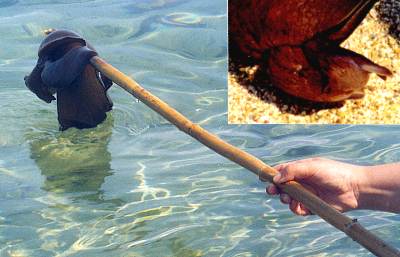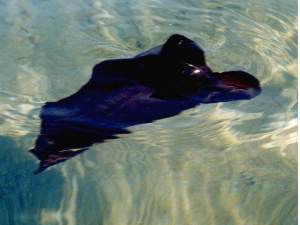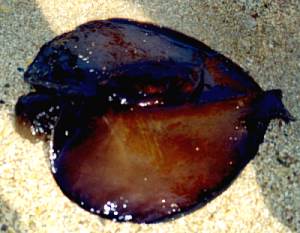Re: Swimming Slug from Greece
August 6, 2002
From: George Sherman

Dear Dr. Rudman:
Thank you for posting my earlier letter and for your tentative identification of my slug as a Sea Hare, probably Aplysia fasciata. My slug does look a lot like the photos of Xavier's 'sea bat' that you posted on 10 July 2002 and the photo of the Aplysia fasciata in the Factsheet. However, there are some differences in shape. Moreover, I saw only one pair of tentacles. So I am sending copies of the photos I have of the animal to you by snail mail just in case it is something different. Also, I'd like to correct an error I made in my original letter. I said that the slug was out of water for about 5 minutes without ill effects, but my fiancee pointed out to me that the boys had replaced it into the water while I was gone looking for a knife to cut off the fishing line around its neck. It was probably out of the water less than 2 minutes.
Sincerely,
George Sherman
gcsherman1@aol.com


Dear George,
Definitely an Aplysia, and almost certainly A. fasciata. I guess the reason the large oral tentacles, alongside the mouth, are not very obvious, for that matter why the whole head is not very obvious, is because it is in some distress. With fishing line around its 'neck' it is trying to contract its head which only ends up making it more swollen [see inset - upper photo]. Sea Hares can survive out of water for some hours if they get stranded at low tide, as long as they are out of the direct sunlight, so being out of the water a couple of minutes would be no great trial.
The lower right photo shows it out of water with the large swimming parapodial flaps extended out on each side of the body.
Best wishes,
Bill Rudman.
Related messages
-
Re: Aplysia brasiliana = Aplysia fasciata?
From: Bill West, February 13, 2009 -
Variation in egg mass color in Brazilian Aplysia fasciata
From: Vinicius Padula, July 10, 2008 -
Aplysia fasciata from Portugal
From: Valter Jacinto, July 2, 2008 -
Sea Hares washed up in Devon, UK
From: Rob Benzies, April 9, 2008 -
Swimming sea slug in France
From: Tim Twibell, October 4, 2007 -
Aplysia fasciata in western France
From: Michael Keys, September 3, 2007 -
Swimming Aplysia in Portugal
From: Gary Leman, August 20, 2007 -
Unidentified Sea Slug from Spain
From: David Gilbert, July 18, 2007 -
Have I been poisoned?
From: Pete Baker, July 17, 2007 -
Aplysia fasciata and A. punctata from Antibes
From: Dominique Horst, June 1, 2007 -
Aplysia fasciata from Greece
From: Hilary Cunliffe-Charlesworth, September 11, 2006 -
Aplysia fasciata? from the Canary Islands
From: Christian Kowalewski, August 21, 2006 -
Swimming Aplysia fasciata from Oeiras, Portugal
From: Ricardo Gomes Afonso, August 9, 2006 -
Are those 3 all Aplysia fasciata ?
From: Stephane Ores, June 9, 2006 -
Sea Hare from Cyprus
From: Helen Coombes, June 7, 2006 -
Aplysia fasciata? from Sao Paulo, Brazil
From: Armando de Luca Jr, March 16, 2006 -
Aplysia fasciata in Portugal
From: Mark Williams, January 28, 2006 -
A swimming Sea Hare from Brittany
From: Kate Bryant, December 5, 2005 -
Re: Aplysia fasciata in Spain
From: Job Tammens, October 14, 2005 -
Swimming Aplysia fasciata from Portugal
From: John Richardson, September 17, 2005 -
Swimming slug from France
From: Robyn Mason-Holt, August 26, 2005 -
Re: Swimming Slug from Greece
From: Graham Smith, July 25, 2005 -
Swimming Aplysia from Greece
From: K. Tzouvali, D. Pettas, April 20, 2005 -
Happy New Year
From: Elif Özgür, December 31, 2004 -
Swimming Sea Hare from Turkey
From: Elif Özgür, December 29, 2004 -
Aplysia fasciata? from Rio de Janeiro
From: Vinicius Padula Anderson, March 25, 2004 -
Aplysia brasiliana = Aplysia fasciata?
From: Bill Rudman, March 25, 2004 -
Sea Hare? swimming
From: A. Agnost, January 6, 2004 -
Andalucian sea creature
From: Peter Stanford, November 17, 2003 -
Re: Aplysia fasciata from Cape Verde Islands
From: Gérard Breton, September 24, 2003 -
Aplysia fasciata from Cape Verde Islands
From: Gérard Breton, August 20, 2003 -
Re: Aplysia from Mediterranean France
From: Marina Poddubetskaia, July 21, 2003 -
Aplysia from Mediterranean France
From: Marina Poddubetskaia , July 19, 2003 -
Aplysia fasciata: 2 colour forms from Senegal
From: Marina Poddubetskaia, June 27, 2003 -
Juvenile of Aplysia fasciata from Senegal
From: Marina Poddubetskaia, June 27, 2003 -
Aplysia fasciata from Israel
From: Bella Galil, May 6, 2003 -
Mottled Aplysia fasciata swimming
From: Joao Pedro Silva, May 3, 2003 -
Re: Aplysia fasciata in Spain
From: Job Tammens, November 27, 2002 -
Swimming Aplysia fasciata (2)
From: Job Tammens and Cisca Dekker, November 22, 2002 -
Swimming Aplysia fasciata from Spain
From: Job Tammens , November 20, 2002 -
Aplysia fasciata swimming
From: Joao Pedro Tojal Silva, November 7, 2002 -
Re: Unknown egg mass from Turkey
From: Erwin Koehler, October 19, 2002 -
Swimming slug? from Greece
From: George Sherman, July 13, 2002 -
'sea-bat' from southwestern France
From: Xavier, July 10, 2002 -
Aplysia fasciata from Portugal
From: João Pedro Silva, June 28, 2002 -
Aplysia fasciata from Portugal
From: Joao Pedro Silva, December 15, 2001 -
Mass Congregation of Aplysia fasciata
From: Hans Rothauscher, February 23, 2001
